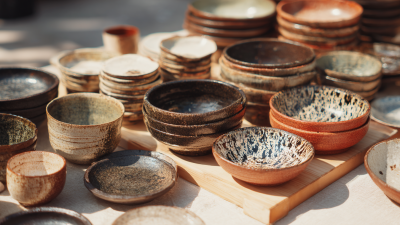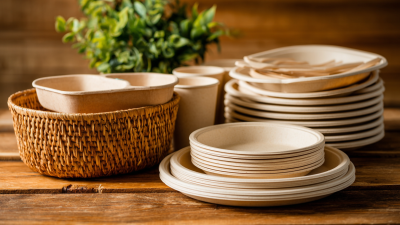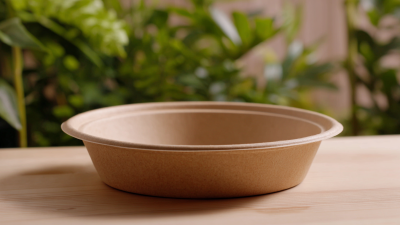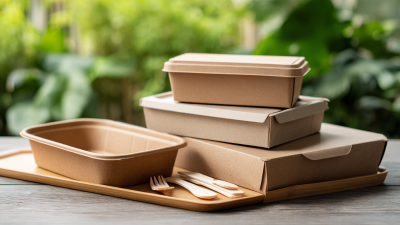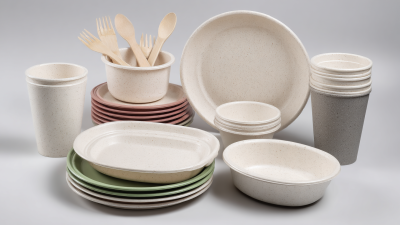In recent years, there has been a significant shift towards sustainability in event planning, with an increasing number of organizers opting for eco-friendly alternatives to traditional plastic products. According to a report by the Environmental Protection Agency, approximately 15 million tons of plastic waste is generated from single-use items annually, with plates being a substantial contributor. As awareness of the environmental impact grows, the demand for Biodegradable Disposable Plates has surged, expected to reach a market value of over $4 billion by 2025, as reported by Smithers Pira. This trend not only reflects the changing consumer preferences but also emphasizes the importance of choosing the right products that align with eco-conscious values. Understanding the key factors in selecting the best biodegradable options can make a crucial difference for any event, ensuring a lower carbon footprint while still providing convenience and functionality for guests.

Biodegradable disposable plates are becoming increasingly popular for events due to their environmental benefits. These plates are typically made from materials like sugarcane, palm leaves, or cornstarch, making them a sustainable alternative to traditional plastic or Styrofoam options. One of the primary advantages of using biodegradable plates is their ability to break down naturally in compost environments, significantly reducing the amount of waste that ends up in landfills. This feature not only aids in decreasing pollution but also contributes to healthier soil when composted, promoting a cycle of sustainability.
Another significant benefit is the impact on guest experience. Eco-conscious attendees appreciate when events prioritize sustainability, enhancing the overall atmosphere and encouraging conversations about responsible consumption. Additionally, biodegradable disposable plates are often designed to be both sturdy and visually appealing, making them suitable for various types of events, from formal weddings to casual picnics. Utilizing these plates can also demonstrate a commitment to environmental stewardship, potentially attracting more attendees who value eco-friendly practices. By choosing biodegradable options, event organizers can align their values with those of their guests while minimizing their ecological footprint.
When selecting biodegradable disposable plates for your event, understanding the key materials is crucial. Look for plates made from natural fibers such as palm leaves, sugarcane (bagasse), or bamboo. These materials not only provide sturdiness but also break down easily in composting environments, making them an excellent choice for eco-conscious gatherings.
Tip: Always check for certifications like ASTM D6868 or EN 13432, which indicate that the products meet compostability standards. This ensures that you're choosing plates that will adequately decompose without leaving harmful residues. Additionally, consider the aesthetic aspect; many natural fiber plates come in attractive designs that can enhance the visual appeal of your event.
Another important material to consider is PLA (polylactic acid), which is derived from renewable resources such as corn starch. PLA plates offer a similar look and feel to traditional plastic, but with the advantage of being biodegradable. However, it’s essential to ensure that they are composted in industrial facilities as they require higher temperatures to break down effectively.
Tip: Avoid plates with a plastic lining, as this can significantly hinder biodegradability. Always opt for companies that are transparent about their materials and provide clear guidelines on disposal. By choosing the right materials, you can hold an environmentally friendly event without compromising on quality or presentation.

When organizing an event, one of the most significant considerations is the cost of disposable dinnerware. Traditional plastic plates, while often cheaper upfront, come with hidden environmental costs. According to a recent report by the Environmental Protection Agency, approximately 35 million tons of plastic waste is generated in the United States each year, with a considerable portion attributable to single-use items like plates. In contrast, biodegradable disposable plates, made from materials such as sugarcane bagasse or PLA (polylactic acid), typically range from 10% to 30% higher in price. However, these costs reflect not only the sustainable materials used but also the environmental impact associated with their disposal.

Further analysis by the Biodegradable Products Institute indicates that while biodegradable plates may represent an initial investment, they lead to significant savings in waste management costs in the long run. Municipalities are increasingly focused on reducing landfill waste, and many offer incentives for sustainable practices. By choosing biodegradable options, event planners not only celebrate occasions responsibly but may also benefit from reduced disposal fees and positive public perception. Therefore, while cheaper options might appeal to immediate budgets, the long-term view favors investing in biodegradable alternatives for both ecological and economic advantages.
When planning an event, choosing the right biodegradable disposable plates is crucial for minimizing environmental impact while still providing functionality. Several top brands in the market stand out for their commitment to sustainability and quality. Notably, brands like Eco-Products, StalkMarket, and GreenWave have received acclaim for their innovative approaches to creating compostable tableware. According to a recent industry report by the Biodegradable Products Institute (BPI), the demand for biodegradable tableware is projected to grow by 25% over the next five years, driven by increased consumer awareness and regulatory pressures.
Eco-Products, for instance, produces plates made from renewable resources like sugarcane and corn starch, making them both eco-friendly and sturdy. Their products are certified compostable by BPI and can break down in commercial composting facilities within 90 days. Similarly, StalkMarket emphasizes using 100% reclaimed agricultural waste for their dinnerware, demonstrating that sustainable practices can go hand-in-hand with quality. The company claims that their plates not only decompose quickly but also offer high resistance to moisture and heat, making them ideal for a variety of event types. Such reliable and eco-conscious brands are paving the way for a more sustainable future in disposable tableware, supporting event planners in making mindful choices.
When planning an event, choosing the right biodegradable disposable plates is essential for both convenience and environmental responsibility. Start by considering the materials used to make these plates. Opt for items crafted from renewable resources like bamboo, sugarcane, or palm leaves. These options not only break down naturally but also add a touch of elegance to your table settings. Be sure to check for certifications that guarantee their biodegradability, as this will give you peace of mind about their environmental impact.
In addition to material, size and design play a crucial role in your selection. Choose plates that fit the type of food you'll be serving, ensuring they can adequately hold everything without risking spills. Also, consider aesthetics; using plates that complement your event theme can enhance the overall experience for your guests. Remember to provide clear instructions on disposal to ensure the plates are handled correctly after the event. By following these eco-friendly tips, you can create a festive atmosphere while minimizing waste.
| Material | Biodegradation Time | Usage Type | Temperature Tolerance | Compostable Certification |
|---|---|---|---|---|
| Sugarcane Bagasse | 60-90 days | Hot & Cold Foods | Up to 200°F | Yes |
| PLA (Polylactic Acid) | 90-180 days | Cold Foods Only | Up to 150°F | Yes |
| Palm Leaf | 60-90 days | Hot & Cold Foods | Up to 200°F | Yes |
| Recycled Paper | 30-60 days | Cold Foods Only | N/A | Yes |
| Bamboo | 50-90 days | Hot & Cold Foods | Up to 200°F | Yes |
